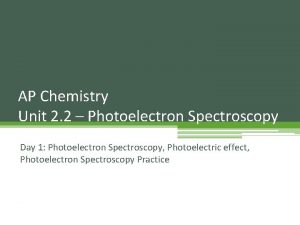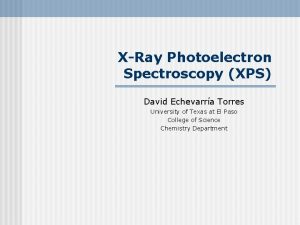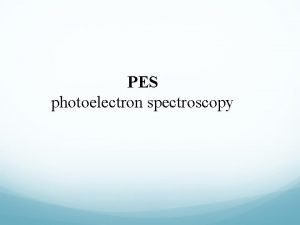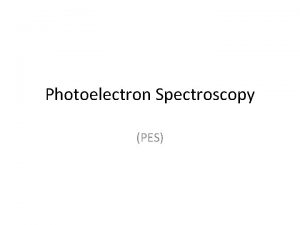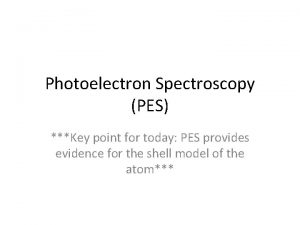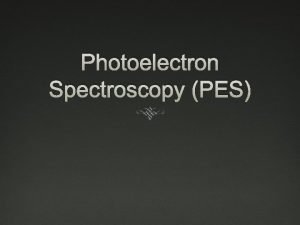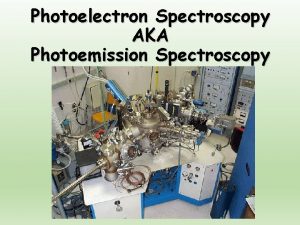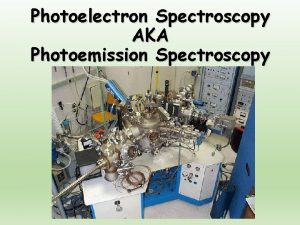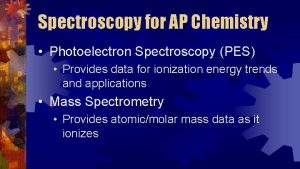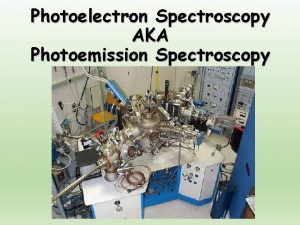Photoelectron Spectroscopy PES Spectroscopy Method of analyzing matter











- Slides: 11

Photoelectron Spectroscopy (PES)

Spectroscopy • Method of analyzing matter using electromagnetic radiation.

Photoelectron Spectroscopy How it works: 1. Sample is exposed to EM radiation 2. Electrons jump out of sample and go through analyzer http: //chemwiki. ucdavis. edu

Number of electrons # PES Data Electrons generally closer to the nucleus Electrons generally farther from the nucleus Each peak represents the electrons in a single sublevel in the atom The bigger the peak – the more electrons Energy to remove an electron (binding energy) (increases to the left!)

Hydrogen vs. Helium Hydrogen #e- energy 1 electron in 1 s energy 2 electrons in 1 s The helium peak is twice as tall because there are twice as many electrons in the 1 s sublevel

Hydrogen vs. Helium Hydrogen #e- energy 1 electron in 1 s energy 2 electrons in 1 s The helium peak is farther to the left (higher energy) thus more energy is needed to remove the 1 s electrons in helium. They must be held more tightly because there is a higher effective nuclear charge. (Helium has 2 protons pulling on 1 s but hydrogen only has 1)

Number of electrons # Oxygen (1 s 22 p 4) 2 electrons in 1 s 2 electrons in 2 s Energy to remove an electron (binding energy) (increases to the left!) 4 electrons in 2 p

Scandium (1 s 22 p 63 s 23 p 64 s 23 d 1) Number of electrons *Notice that it takes more energy to remove an electron from 3 d than from 4 s. This is because as electrons are added to 3 d they shield 4 s thus it’s 2 in 1 s 2 in 3 s easier (takes less energy) to remove 4 s electrons compared to 2 in 2 s 6 in 2 p 3 d electrons. Remember when transition metals make positive ions - it’s the s electrons that are lost first! 6 in 2 p 1 in 3 d Energy to remove an electron (binding energy) (increases to the left!) 2 in 4 s

Example 1: Number of electrons Identify the element whose PES data is shown to the right. Sodium Why is one peak much larger Than the others? This peak represents 6 electrons In the 2 p sublevel the other Peaks represent only 1 or 2 electrons In which sublevel are the electrons Represented by peak A 3 s A Energy

Example 2: Oxygen Nitrogen #e- energy The PES data above shows only the peak for the 1 s electrons. Why is the peak for Nitrogen farther to the right? It takes less energy to remove a 1 s electron from nitrogen because it has a lower Effective nuclear charge (less protons) than oxygen

Example 3: Number of electrons Draw the expected PES Spectrum for the element boron Energy
 Pes spectrum for magnesium
Pes spectrum for magnesium Photoelectron spectroscopy pogil
Photoelectron spectroscopy pogil Spectroscopy ap chem
Spectroscopy ap chem Xray photoelectron spectroscopy
Xray photoelectron spectroscopy Pes spectroscopy
Pes spectroscopy Boron pes
Boron pes Section 1 composition of matter
Section 1 composition of matter Grey matter of nervous system
Grey matter of nervous system Classification of matter section 1 composition of matter
Classification of matter section 1 composition of matter Chapter 2 section 1 classifying matter answer key
Chapter 2 section 1 classifying matter answer key What makes up the diencephalon
What makes up the diencephalon Composition of matter section 1
Composition of matter section 1


